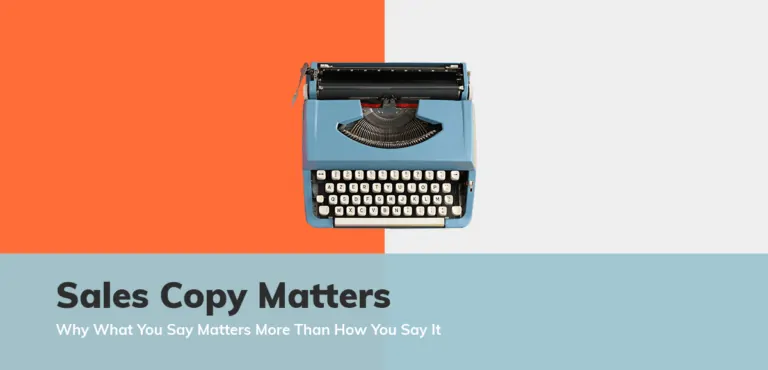When it comes to writing effective sales copy — the kind that moves people to action — knowing what to say is far more important than how you say it.
Far too many copywriters and marketers spend the bulk of their time obsessing over choosing the perfect words, checking their grammar, and revising countless drafts, all to make sure everything is “just right.”
And while there is value to making sure you convey your sales message as best you can, figuring out what to say in the first place should be where you spend most of your time and effort.
When you do, you’ll see improved results — more clickthroughs, higher conversions, and a bigger bottom line.
Why Figuring Out What to Say Is Your #1 Task
Pretend you’re in a foreign country.
You’re lost and want to get back to your hotel. You know you can’t be that far away and spot a stranger on the street who might be able to help. As you approach him, what’s the biggest concern on your mind… is it:
- Worrying about how perfectly you’re going to say what you want to ask? Or…
- Making sure you figure out exactly the right thing to say, so you don’t accidentally ask them where the bathroom is, instead of your hotel?
If you plan on getting your desired result, what you ask that stranger is of critical importance!
When it comes to communicating your marketing message to your audience, it really is no different.
Your audience speaks a foreign language — one made up of their beliefs, desires, values, needs, wants, and more.
It’s your job to figure out what this language is, and then figure out what to say so you get your desired result. The rest is — for the most part — details.
Legendary copywriter and brilliant marketer Dan Kennedy, calls this the message-to-market match.
Your message needs to match your intended market. The right message to the wrong market will flop. By the same token, the wrong message to the right market will do just as bad.
Back in the 80s, the now-defunct Braniff International Airlines ran a series of ads that had the wrong message to the right market. They were hoping to appeal to Spanish-speaking first-class travelers.
The ad agency they hired went with the literal translation of Braniff’s tagline, “Fly in leather,” without thinking through what it was they were really saying.
The ads would entice folks with “Vuela en cuero.” For those familiar with Spanish slang, the airline was telling them to “Fly naked!”
The Swedish company Electrolux made sure their message-to-market match was on target.
They opted not to run a long-standing campaign in the U.S. that had done very well in the United Kingdom. The campaign heralded the slogan, “Nothing sucks like an Electrolux.”
So I don’t keep rambling on, let’s take a look at “live” examples of what it means to be on target with the “what” in your marketing copy (or any other written communications, for that matter).
Sites That Got the “What” Right
The following three sites really put in some effort and serious thinking to get their message just right… is it any coincidence they are very successful in their respective markets? (The answer, of course, is no! )
MailChimp
MailChimp is an email autoresponder service, offering the ability to create, track, and send simple plain-text emails and fancy (if you want) html email newsletters.
Take a look at the copy on their home page:
There isn’t much copy before the call to action to “Sign Up Free.”
But the copy that is there is enough to get the job done. It conveys the proper WHAT to the right market. Here’s the copy as it currently reads on the site:
“Easy Email Newsletters
3 million people use MailChimp. Sign up and join them today.
MailChimp helps you design email newsletters, share them on social networks, integrate with services you already use, and track your results. It’s like your own personal publishing platform”
The “what” here is virtually perfect. It’s to the point and addresses the “language” of their audience. Would this homepage be as effective if they said something totally different?
Maybe something like, “MailChimp — The trusted autoresponder and email list management service for 3 million happy users. Sign Up Free”
My guess is most likely not. They’ve identified what their audience REALLY wants, which is an easy way to create, send, and track emails. Their headline conveys that immediately.
Now, what if they focused on the “how” part of their message. Do you feel that saying “Simple Email Newsletters” versus “Easy Email Newsletters” would make a big difference?
Or maybe they could say: “Email Newsletters Made Simple.”
We could spend hours tweaking the copy they’ve already got. But I doubt it would make as big of an impact as figuring out what they wanted to say in the first place (i.e. going from “MailChimp — The trusted autoresponder and email list management service for 3 million happy users” to “Easy Email Newsletters”).
KISSmetrics
Crazy Egg’s sister company, KISSmetrics, is a provider of website analytics that helps you identify, understand, and improve key business metrics that’ll lift conversions and profits.
Take a look at the copy on their main landing page:
Again, they know their audience and have really thought about WHAT to say. With this copy, KISSmetrics is meeting their audience where they are at mentally.
This market is clearly looking for more specific data on their web visitors than can be gathered with free analytics solutions.
The copy reads:
“Google Analytics tells you what happened.
KISSmetrics tells you who did it.
KISSmetrics fills this gap by showing you every action each individual did. Finally, you’ll know who your most valuable customers are and how to get more of them.”
Would this be as effective if KISSmetrics had settled on a different “what?”
Maybe something like… “Improve Key Performance Indicators In Your Business With Customer-Centric Analytics Tools.”
I’d be willing to bet dollars to donuts that it wouldn’t be anywhere near as effective.
And what of tweaking the copy that KISSmetrics has currently? Again, it probably won’t make that big of a difference in opt-in rates, so long as the core message remains the same. (“Google Analytics tells you what happened. KISSmetrics tells you who did it.”)
Dev Bootcamp
Let’s take a look at one last example — Dev Bootcamp. They’ve recently garnered a ton of free press because they’re offering a unique way to learn the skills of becoming a sough-after, highly-paid web developer.
Instead of bogging their students down with knowledge they’ll never use once they enter the workforce (as would happen with a traditional, four-year degree), Dev Bootcamp teaches only the necessary skills that’ll be used and valued in the workplace.
The copy is short, simple, and to the point:
It reads:
“IN 9 INTENSE WEEKS
You will become a web developer”
They could of said, “Earn more with a career in programming for the web… Dev Bootcamp will give you the skills you need to succeed. Find out more.”
Again, it wouldn’t be as effective as the “what” they currently have.
Could we tweak how they’re saying what they’re saying?
Of course. They could say, “You: a web developer in just 9 intense weeks.” Or “Become a web developer in just 9 short weeks.”
No matter how you say it, the message is still clear and will appeal to their target audience.
“Okay, Okay… I Get It Already! HOW Do I Figure Out WHAT To Say?”
One word:
Research. Plenty of it.
And that means going beyond the “basics.”
You should already know the demographics of your audience (i.e. gender, age, location, etc.)
Instead, you should really follow the old cliché of walking a mile in your prospect’s shoes.
What does he or she believe? What emotions does he experience on a daily basis? What secret desires does she have that she never shares with anyone else?
One great way to get this kind of valuable info is to visit forums related to the market you’re in.
See what conversations are going on. Notice the words being used, and the emotions, opinions, beliefs, etc that are being expressed.
You could also visit blogs in your market. See what’s being talked about. Take a look at the comments too.
Social media is also a great way to tap into the conversations that are going on between those in your target audience.
Finally, perhaps the best thing you can do is interview your current and past customers. Find out what made them become your customer versus the competition. Why did they buy? What needs/desires did your product or service satisfy? What do they like most about it?
Dig deep and get as much info as you can.
This is the kind of work you should do before writing a single word of copy.
And when you put in the elbow grease required to do this kind of research, the “what” will become that much easier to figure out. Better yet, it’ll probably be right on the mark, leading to improved results, better conversions, and bigger profits (as a bonus, the HOW will practically write itself!).
This post was originally published on CrazyEgg.com







